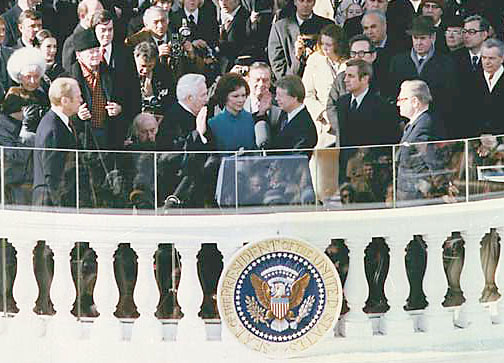 A man to be emulated?
A man to be emulated?
Jimmy Carter. The name itself is enough to make anyone over the age of forty-five shudder with revulsion. Few presidents in American history have managed to generate as much bi-partisan contempt and popular frustration as the “Master of Malaise.” During his mercifully short tenure in the Oval Office, President Carter accumulated an unprecedented record of policy errors that still makes those old enough to remember think twice before buying a new sweater. With such a horrific legacy of foreign and domestic blunders, it is little wonder why many count his as the most ineffective administration since James Buchanan’s.
Yet, in a recent article in The Wall Street Journal, columnist Holman Jenkins suggest that President Carter is a man to be emulated instead of written off by our current Democratic leadership. In an age in which most conservative journalists delight in comparing the inadequacies of the Obama Administration to the achievements of the Reagan White House, few have contrasted our sitting president with any other commander-in-chief until now. In a well-reasoned piece, Mr. Jenkins suggests that it is not Ronald Reagan that Mr. Obama plays foil to, but good old Jimmy Carter.
Much like Barack Obama, President Carter entered the White House on the heels of an unpopular administration that had left a regrettable economic legacy. Having ridden a wave of “Watergate revulsion” into the Oval Office, Carter did not associate himself with any economic policies during the campaign, and thus had considerable freedom to develop his agenda after his election. Despite his “progressive” sentiments, President Carter was adult enough to substitute the nation’s priorities for his own. It certainly cut against his principles when he set about dismantling the regulatory state that he and his Democratic colleagues had constructed. He certainly sacrificed his big-government sympathies when he appointed Paul Volcker, an early monetarist, to head the Federal Reserve. And it most definitely undermined his progressive credentials when he bragged of “slashing regulations” and “restoring the free enterprise system” to regulated industries at the 1980 Democratic Convention. Despite his many failings, Carter’s willingness to put aside his political and ideological doctrines to do what was best for the country defined him as a leader, albeit a rather useless one.
In much the same way, Barack Obama slithered his way into the Oval Office as the electorate backed away from the policies of the Bush White House. With his infamously amorphous campaign slogans, Mr. Obama stood for nothing besides “change” and “hope” prior to his election. As a result, he too was free to establish an agenda that was untried in the polling place after his election. But where he differs from President Carter is in his willingness to compromise on his liberal tendencies to pursue the well being of the nation. From his ineffective stimulus plan, to the abomination of Obamacare, to his recent rejection of Pat Tommey’s tax-reform plan, Mr. Obama has stuck to his progressive guns with disastrous consequences. By playing petty politics in support of his own half-baked ideology, Mr. Obama has done the unthinkable. He has made Jimmy Carter look good.
You can read Mr. Jenkins’ article here.
—Nick Desatnick

Be the first to comment on "Making Carter Look Good"